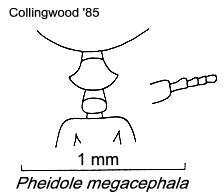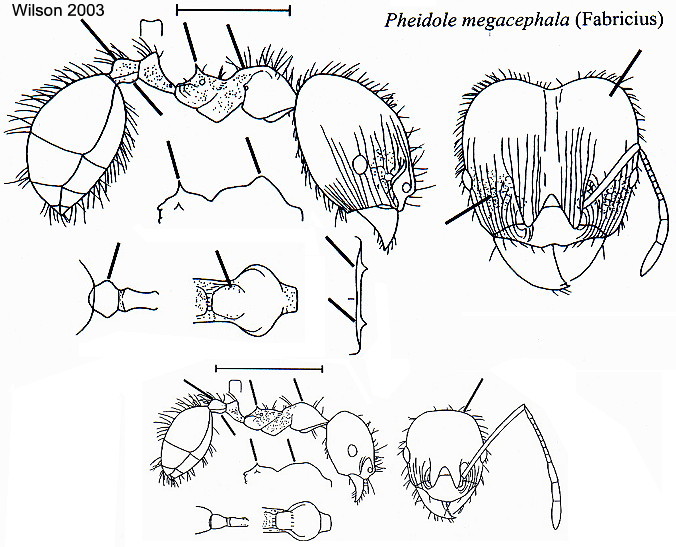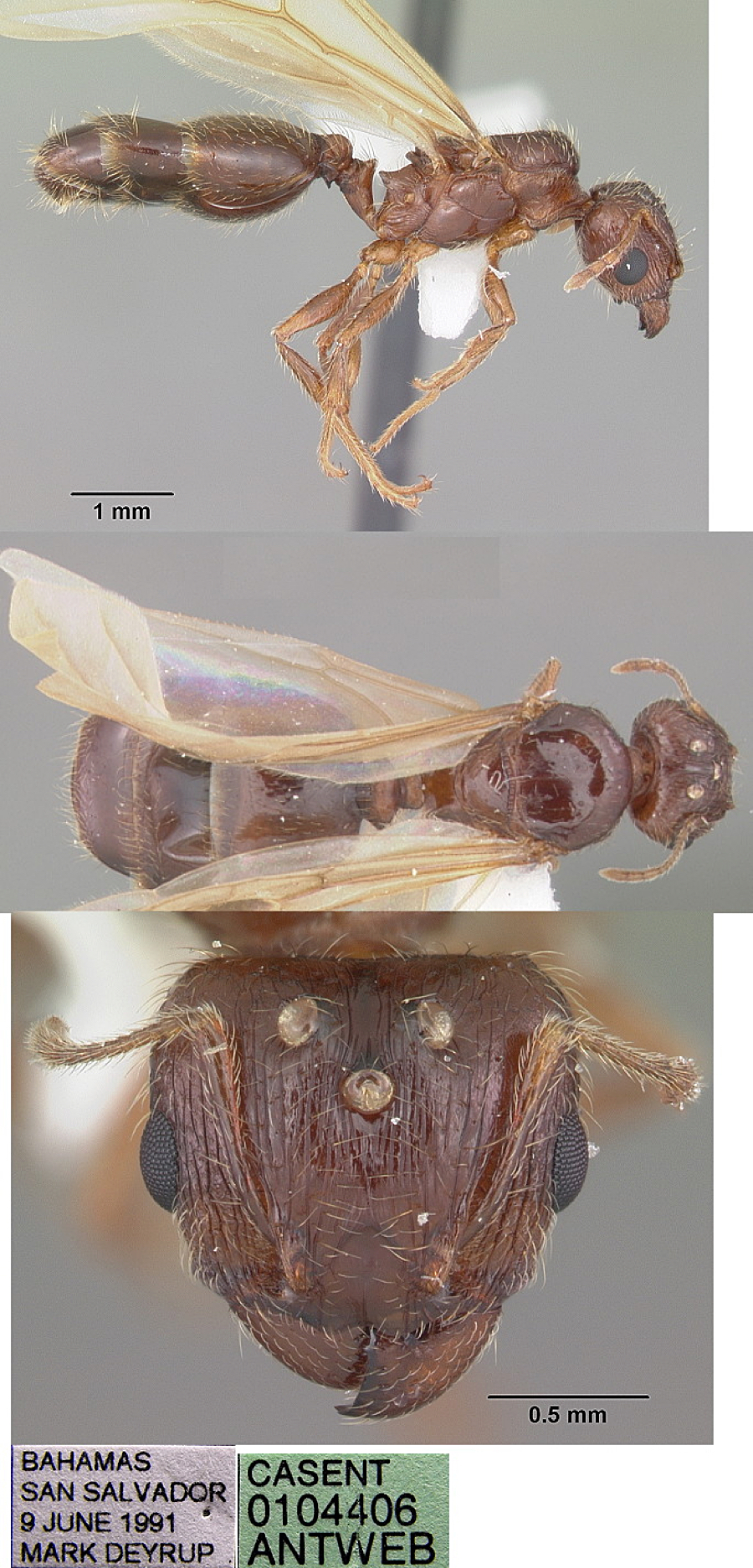Pheidole megacephala (Fabricius)
 MAJOR MAJOR  MINOR Type location not known (Formica
megacephala, Fabricius, 1793: 361, major) [note Wheeler, 1922, has
the type locality as Mauritius
= "Isle de France", as per the
specimen label, see photomontage on the linked majors page (see below);
but Forel,
1891: 176, reckoned
the location was Madagascar; the area around Paris, however, was and is
known as the "Isle de France" and it seems possible that "Museé"
specimens in the Bosc. collection were found in a hot house in France]
MINOR Type location not known (Formica
megacephala, Fabricius, 1793: 361, major) [note Wheeler, 1922, has
the type locality as Mauritius
= "Isle de France", as per the
specimen label, see photomontage on the linked majors page (see below);
but Forel,
1891: 176, reckoned
the location was Madagascar; the area around Paris, however, was and is
known as the "Isle de France" and it seems possible that "Museé"
specimens in the Bosc. collection were found in a hot house in France]
Subspecies (Bolton,1995)
duplex (Pheidole
megacephala F. v. duplex
n. var., Santschi, 1937d:
218,
major, minor & queen) from Angola - see http://www.antweb.org/specimenImages.do?code=casent0906513
appear identical to the fresh specimens I have (linked pages)
junior synonyms
perniciosa (Oecophthora perniciosa,
n. sp., Gerstäcker, 1859: 263, minor; junior synonym of megacephala,
Emery, 1915j: 235) from Mozambique - see (headless) http://www.antweb.org/specimenImages.do?code=casent0906517
laevigata (Myrmica
(?) laevigata sp. nov., F Smith, 1855b: 130, illustrated,
minor; junior synonym
of pusilla, Roger, 1859: 259, of pallidula, F Smith,
1858a: 282; of megacephala, Roger, 1863b: 30; of pusilla,
Emery, 1915j: 235) from Great Britain, collected at Battersea
[also name used by Mayr,
1862: 747, minor, for specimen from Brazil]
speculifrons
(Pheidole megacephala F. v. speculifrons n. v., Stitz, 1911b:
386, major & minor)
from Tanzania, Bukoba - on linked pages (see below)
suspiciosa (Myrmica
suspiciosa, F.
Smith, 1859a: 148, minor; junior synonym of megacephala,
Donisthorpe, 1932c: 455) from Indonesia, Aru - see http://www.antweb.org/specimenImages.do?code=casent0901409.
testacea (Atta
testacea, F Smith, 1858b: 168, major & minor; junior synonym of
megacephala, Brown, 1981: 530) from Brazil  . .
Note: Fischer & Fischer (2013) designated a
"neotype"; I feel that was unnecessary given that good specimens of the
junior synonyms exist, e.g. duplex.
[Fischer, G.; Fisher, B. L. 2013. A revision of Pheidole Westwood (Hymenoptera:
Formicidae) in the islands of the Southwest Indian Ocean and
designation of a neotype for the invasive Pheidole megacephala. Zootaxa 3683:301-356.]
|
Fabricius's (1793) description is at  . Gerstäcker's (1859) description of perniciosa
(worker) is at . Gerstäcker's (1859) description of perniciosa
(worker) is at  . F Smith's (1855b) description of laevigata
(worker) is at . F Smith's (1855b) description of laevigata
(worker) is at  . F Smith's (1859a)
description of suspiciosa (worker) is at . F Smith's (1859a)
description of suspiciosa (worker) is at  ; note his comment on laevigata
that appears to contradict his own explicit remark only a short time
before (F Smith 1858a, see below). F Smith's (1860b: 112) description
of megacephala, major & minor workers, from Bachian,
Celebes, is very weird and obviously not the type form, this is at ; note his comment on laevigata
that appears to contradict his own explicit remark only a short time
before (F Smith 1858a, see below). F Smith's (1860b: 112) description
of megacephala, major & minor workers, from Bachian,
Celebes, is very weird and obviously not the type form, this is at  ; Mayr's (1861) description (all forms,
with a key to separate megacephala and pusilla) is at ; Mayr's (1861) description (all forms,
with a key to separate megacephala and pusilla) is at  . Forel's (1891b) description is at . Forel's (1891b) description is at  . and . and  . Forel's (1907g) description of ilgi
is at . Forel's (1907g) description of ilgi
is at  . Emery (1915j) sought to clarify the megacephala-group
of species, with and illustrations - see . Emery (1915j) sought to clarify the megacephala-group
of species, with and illustrations - see  .
Emery (1919a) gave further notes and corrected illustrations - see .
Emery (1919a) gave further notes and corrected illustrations - see  . Arnold's (1920a) translation of ilgi
(as ilgii) is at . Arnold's (1920a) translation of ilgi
(as ilgii) is at  . Santschi's (1937d) description of duplex
is at . Santschi's (1937d) description of duplex
is at  . .
|
Notes - changes from the Bolton (1995: 325)
listing by BT, see http://antsofafrica.org/ant_species_2012/pheidole/pheidole_megacephala/pheidole_megacephala.htm
for the non-Egyptian species pages:
- costauriensis - Bolton (1995: 320) had Pheidole
rotundata st. costauriensis as "Subspecies of megacephala:
current status". Santschi's (1914a, 1915c) descriptions of Pheidole
rotundata stirps costauriensis, coupled with Emery's
(1915c) drawing of melancholica and my own drawings of "Pheidole
crassinoda" have led me to elevate Pheidole costauriensis
to species.
- edax - the junior synonym edax
(Formica edax, Forskål, 1775: 84, worker) from Egypt.
Wide surveys of Egypt have never definitely found P. megacephala
and from the original description this is more likely to be a variety
of Pheidole
fervens.
- janus - from the illustration it has to
be said that janus (Pheidole janus, F Smith 1858b: 175,
illustrated , soldier & minor) from Sri Lanka, is not a megacephala
variety nor would it be P. teneriffana; it seems Wheeler (1922:
812) was responsible for the errors in synonymy. Pheidole janus
may well merit revived species status but is extralimital to this
website. F Smith's (1858b) description of janus is at
 . .
- laevigata (Myrmica laevigata, F
Smith, 1855b: 130, illustrated, worker; junior synonym of pusilla,
Roger, 1859: 259, of pallidula, F Smith, 1858a: 282; of megacephala,
Roger, 1863b: 30; of pusilla, Emery, 1915j: 235) from Great
Britain [also name used by Mayr, 1862: 747, major, for specimen
from Brazil, as Pheidole laevigata n. sp]. F Smith's (1858a)
note confused the situation, as he stated, Myrmica laevigata F.
Smith (1855b) was a junior synonym of Myrmica pallidula, i.e Pheidole
pallidula. His descriptions of the major and sexuals clearly
are ofpallidula. The explanation for the confusion surely is
that Smith only had minors of laevigata, a situation that
re-occurred a little later (F Smith 1859a) when he felt the minor of suspiciosa
and laevigata wer similar. F Smith's (1855b) description of laevigata
(worker) is at
 and his (1858a) note is
at and his (1858a) note is
at  . .
- melancholica - I also regard Pheidole
melancholica (Santschi, 1912b), from Ivory Coast, as a distinct
species in the crassinoda-group.
- nkomoana - Forel (1916) felt Ph.
megacephala new strips nkomoana could well be a separate
species. With my own description and drawings of "Pheidole
species E", I have raised Pheidole nkomoana to species status.
- pusilla - on examination of the
description and illustration of pusilla (Oecophthora pusilla,
Heer, 1852: 15, illustrated, all forms; also illustrated by Emery,
1919a) from Madeira (with junior synonyms janus, F
Smith, 1858b: 175, illustrated, major & minor workers) from Sri Lanka
are clearly not megacephala; pusilla appears to be a
separate species, Pheidole pusilla. Mayr (1861) separated
major, minor and queens from megacephala; Mayr (1870: 981,
footnote) noted that his Pheidole laevigata (Mayr, 1869, on
"page 99", i.e. the 99th page of the text, actually numbered p. 747).
- talpa - I agree with Dalla Torre (1893:
95) and Emery (1915j: 235) that Pheidole talpa (Gerstäcker,
1871: 356, major; Santschi, 1930b: 67, worker & queen) is a
junior synonym of Pheidole punctulata and not of megacephala
as thought by Santschi (1925h: 160) and listed in Bolton (1995: 331) -
note specially the rhomboid pronotum with acute angles, characteristic
of punctulata.
- trinodis - from the original
description by Losana (1834), it seems obvious that trinodis (Myrmica
trinodis, Losana, 1834: 327, illustrated, worker; synonymy Roger,
1863: 30) from Italy, see
 , is not a junior synonym of megacephala
and is not even a Pheidole - Losana emphasises the presence of
four spines on the propodeum, i.e. possibly it was a Tetramorium.
The confusion by Roger (1863b: 30, followed in Bolton, 1995) probably
was caused by Losana's immediately following description of specimens
of Myrmica megacephala Latr.- "the megacephala of
Latreille" - , is not a junior synonym of megacephala
and is not even a Pheidole - Losana emphasises the presence of
four spines on the propodeum, i.e. possibly it was a Tetramorium.
The confusion by Roger (1863b: 30, followed in Bolton, 1995) probably
was caused by Losana's immediately following description of specimens
of Myrmica megacephala Latr.- "the megacephala of
Latreille" -  ; as Losana wrote of the ant as nesting in
our garden, in Piemonte (Piedmont), in northwest Italy, he almost
certainly was reporting on Pheidole
pallidula; note his description of a lion-coloured ant. In
fact, the latter was the opinion of Emery & Forel (1879: 463). ; as Losana wrote of the ant as nesting in
our garden, in Piemonte (Piedmont), in northwest Italy, he almost
certainly was reporting on Pheidole
pallidula; note his description of a lion-coloured ant. In
fact, the latter was the opinion of Emery & Forel (1879: 463).
|
 Note: There are no confirmable reports from Egypt. Note: There are no confirmable reports from Egypt.
Collingwood (1985), describing specimens he recorded from
Saudi Arabia, included the illustration right of the pedicel dorsum and
base of the funiculus. He noted promesonotal outline evenly curved
without a distinct mesonotal prominence and funicular segments 2, 3
& 4 not longer than broad.
|
With the availability of specimens from
sub-Saharan Africa and Saudi Arabia, the link pages give fresh
photographs and descriptions of
Major
workers; Minor
workers
|
 This may be one of the world's most widely distributed,
and perhaps most ubiquitous, tropical species. Hölldobler & Wilson
(1990, page 118) picture specimens, from the Pacific Island of Samoa,
which look very similar to those I have drawn. They also remark on it
being notable for high local abundance and that it often 'extirpates'
many other species of ant (pages 399-400). The drawing is from Wilson's
(2003) review of the Pheidole of the New World. This may be one of the world's most widely distributed,
and perhaps most ubiquitous, tropical species. Hölldobler & Wilson
(1990, page 118) picture specimens, from the Pacific Island of Samoa,
which look very similar to those I have drawn. They also remark on it
being notable for high local abundance and that it often 'extirpates'
many other species of ant (pages 399-400). The drawing is from Wilson's
(2003) review of the Pheidole of the New World.
|
 Queen
- photomontage collated from http://antweb.org/specimen.do?name=casent0104406. Queen
- photomontage collated from http://antweb.org/specimen.do?name=casent0104406.
|
|